There are numerous occasions when we need a rope to be pulled very tight and secured while not losing any tension. The most obvious of these circumstances is when securing a load to one’s truck or trailer and the truckers who make their living driving goods around the country know a thing or two about tying down a load.
The Trucker Hitch is a series of knots that form a primitive style of block and tackle which will allow you to pull cordage taut and secure the line without losing tension.
The Trucker hitch also has several variants that use slightly different techniques to achieve the end goal, but what I will show here is the method that I use and have had a lot of success with.
Related: 4 More Knots A Prepper Needs To Know For Survival
Trucker Hitch Uses
The Trucker Hitch is primarily used to secure loads but can be very useful in any situation where you need to tighten and secure a line.
I like to use a Trucker Hitch to create a very taut ridgeline off which I can string a tarp to make a tarp shelter. I also use this knot to tighten and secure lines for flying tarps while setting up a camp.
Knot Tying Terminology
To make it easier to follow along with the tying instructions it is helpful to know a few common knot and rope terms.
Bight – A bight is a U-shaped section of rope that is not crossed over itself making it different than a loop. A bight can be at any part of the cordage.
Loop – A loop is where the cordage is crossed over itself to form a loop. A loop can be either overhand or underhand depending on which end of the rope is crossed overtop the other. An overhand loop has the working end crossed overtop the standing end and an underhand loop is the opposite.
Working End – This is the end of the rope that is being used to tie the knot.
Standing End – This end of the rope is opposite the working end and is static.
Materials Required
Aside from cordage, you will need something in which to either run the cordage around or through to aid you in tightening the line.
Related: Making Cordage From A Plastic Bottle
How To Tie The Trucker Hitch
#1. Secure one end of the cordage to the opposite side from where you want to tie the knot. This can be a tree, pole, trailer tie-down point, etc.
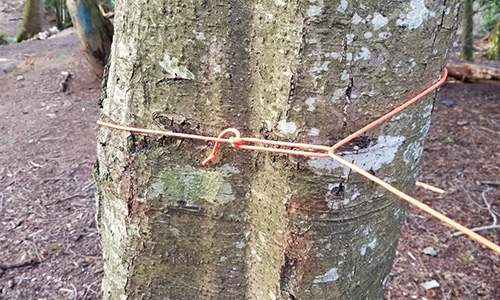 #2. Locate your next tie-off point and run the working end around it, or in the case of a ring, through it. Pull the cordage so that it is snug.
#2. Locate your next tie-off point and run the working end around it, or in the case of a ring, through it. Pull the cordage so that it is snug.
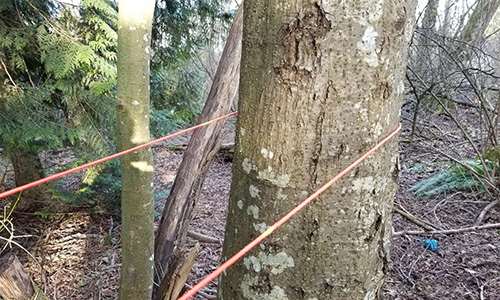 #3. Pick a point several feet away from where the cordage runs around the tie-off point. This is where you will tie your loop.
#3. Pick a point several feet away from where the cordage runs around the tie-off point. This is where you will tie your loop.
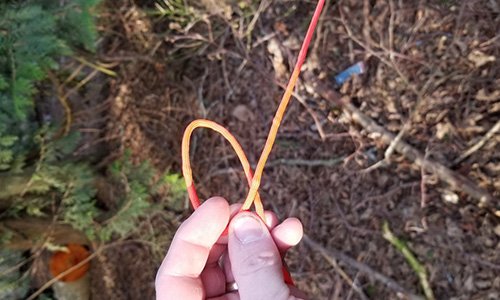
#4. Make an overhand loop. From here take a bight of cordage from the working end next to the overhand loop.
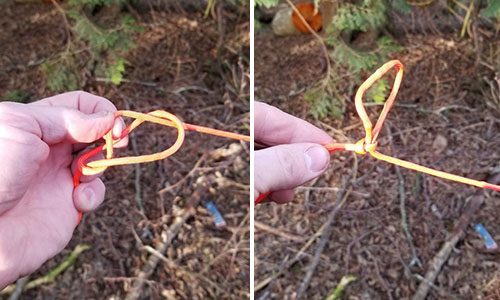 #5. Pass the bight through the overhand loop from the rear and carefully dress up the knot. What I like to do is to keep hold of the bight and pull the overhand loop closed around it. You want to end up with a slipknot that has a loop of a couple of inches wide.
#5. Pass the bight through the overhand loop from the rear and carefully dress up the knot. What I like to do is to keep hold of the bight and pull the overhand loop closed around it. You want to end up with a slipknot that has a loop of a couple of inches wide.
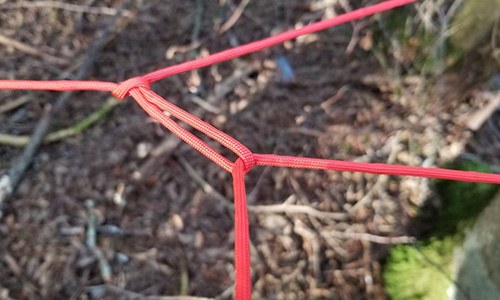 #6. Now that you have your slipknot loop, pass the working end of your cordage through it.
#6. Now that you have your slipknot loop, pass the working end of your cordage through it.
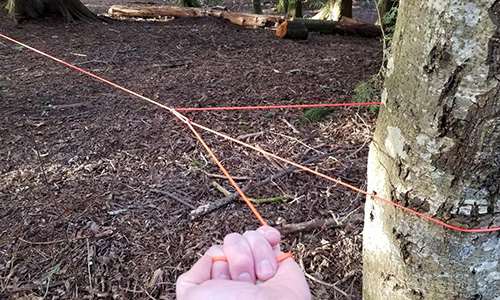 #7. Pull the line taut.
#7. Pull the line taut.
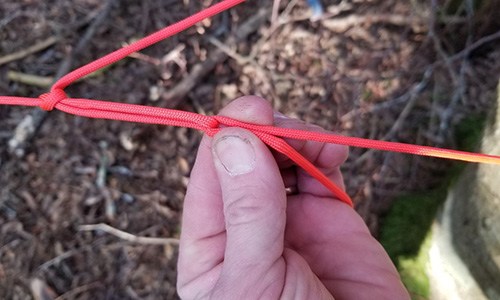 #8. When the line is tight enough pinch the cordage where it passes through the slip knot loop.
#8. When the line is tight enough pinch the cordage where it passes through the slip knot loop.
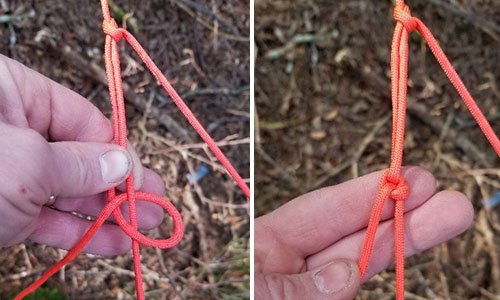 #9. Secure the line with two half hitches. It will take a little practice to be able to secure this hitch without losing any tension but it is possible to do so.
#9. Secure the line with two half hitches. It will take a little practice to be able to secure this hitch without losing any tension but it is possible to do so.
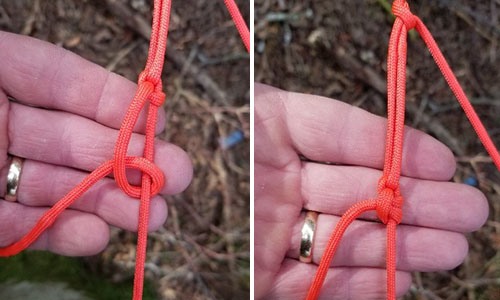 Variations Worth Noting
Variations Worth Noting
Instead of using a slip knot loop, an alpine butterfly loop can be used instead.
#1. Lay the cordage across your palm.
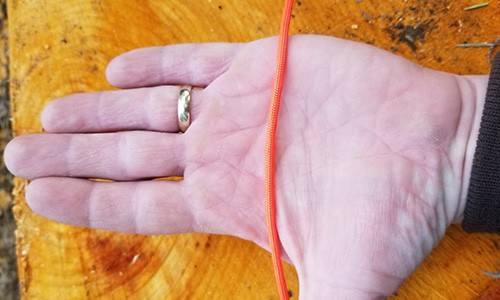 #2. Loop the working end of the cordage behind your hand and across the tips of your fingers.
#2. Loop the working end of the cordage behind your hand and across the tips of your fingers.
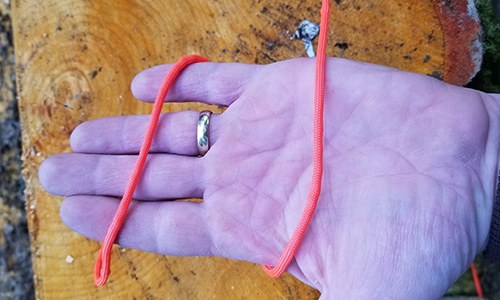 #3. Loop the cord back across your palm.
#3. Loop the cord back across your palm.
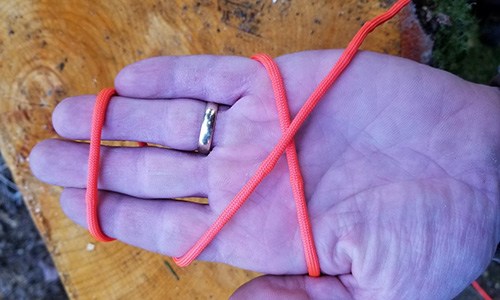 #4. Pull the line that lays across your fingers down and over the crossed lines on your palm.
#4. Pull the line that lays across your fingers down and over the crossed lines on your palm.
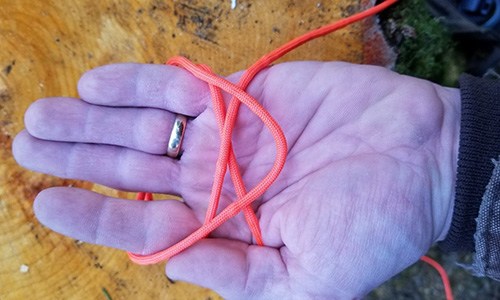 #5. Push the line under both lines on your palm and up towards your fingers.
#5. Push the line under both lines on your palm and up towards your fingers.
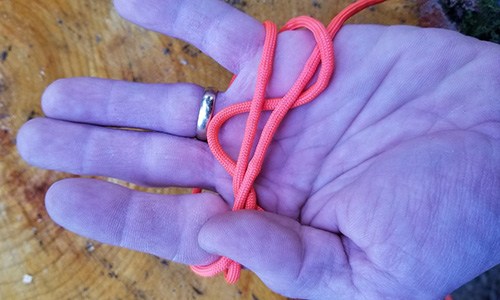 #6. Hold on to this loop with your free hand and remove your hand from the cordage.
#6. Hold on to this loop with your free hand and remove your hand from the cordage.
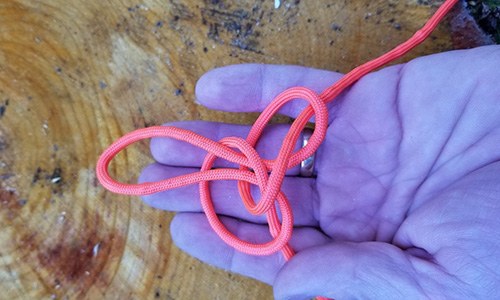 #7. Dress the knot by holding the loop at the size that you want and pulling either line until the knot is tight.
#7. Dress the knot by holding the loop at the size that you want and pulling either line until the knot is tight.
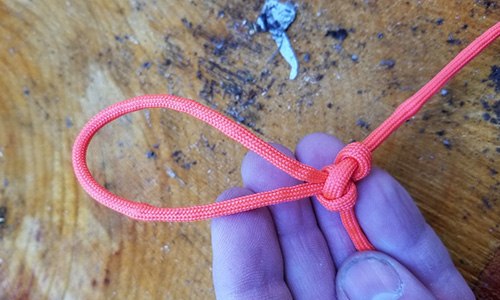 The advantage of using a loop such as the alpine butterfly loop is that when practiced it can be very quick and easy to tie. The one disadvantage is that it is not as rapidly untied as the slip knot loop.
The advantage of using a loop such as the alpine butterfly loop is that when practiced it can be very quick and easy to tie. The one disadvantage is that it is not as rapidly untied as the slip knot loop.
Using a Slipknot Loop Instead Of Two Half Hitches
You can also use a slip knot loop to secure the Trucker Hitch. This is what I like to when securing a ridgeline for a tarp shelter.
Related: 3 Quick Shelters (The Last One is Invisible!)
Step 1: After step 8 of the Trucker Hitch, take a bight of the working end next to where you have pinched the line.
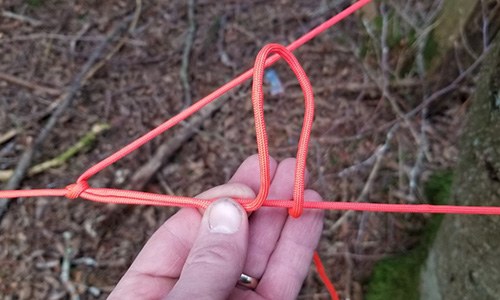 Step 2: Take another bight and pass it up through the backside of the first bight. This second bight is what makes the loop of your slipknot, so when you dress up the knot in the next step, hold onto this bight.
Step 2: Take another bight and pass it up through the backside of the first bight. This second bight is what makes the loop of your slipknot, so when you dress up the knot in the next step, hold onto this bight.
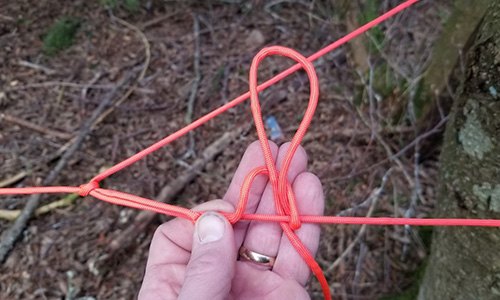 Step 3: Carefully dress up the knot leaving a loop of a few inches in diameter.
Step 3: Carefully dress up the knot leaving a loop of a few inches in diameter.
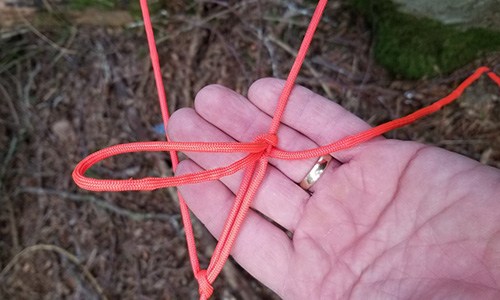 Step 4: Coil the remaining cordage and place it inside of the slipknot loop. You can now tighten the slipknot loop around the coiled cordage which will prevent it from accidentally untying.
Step 4: Coil the remaining cordage and place it inside of the slipknot loop. You can now tighten the slipknot loop around the coiled cordage which will prevent it from accidentally untying.
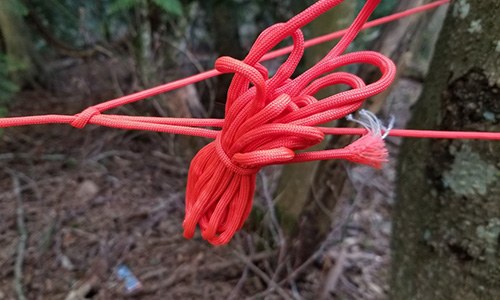 I like to use the slip knot loop because it means I can take down my ridgeline or tarp lines very quickly and efficiently. It also lets me secure the excess cordage reducing the need to cut it.
I like to use the slip knot loop because it means I can take down my ridgeline or tarp lines very quickly and efficiently. It also lets me secure the excess cordage reducing the need to cut it.
Why Preppers And Survivalists Should Know The Trucker Hitch
While there are many important knots that we should know as preppers and survivalists, the Trucker Hitch is one that has been my go-to knot for quite some time.
Securing loads, hanging bear bags, running ridgelines, flying tarps, and securing guy lines are only a few of the tasks that I have used a Trucker Hitch to complete.
Even in my daily life at work and around the home the Trucker Hitch is in regular use.
This is a hitch that I use so often it has become second nature for me. I have even practiced securing a ridgeline with this hitch one-handed with some success.
While it does take a little practice to get the feel for how to tie this knot once you understand the basic process it becomes an exceptionally versatile hitch to have in your knot-tying toolbox.
You may also like:
5 First Aid Skills Every Senior Should Know
How to Make Bark Bread from a Tree that Grows on Almost Every Street in America (Video)
Survival Uses For Drinking Straws You Normally Throw Away

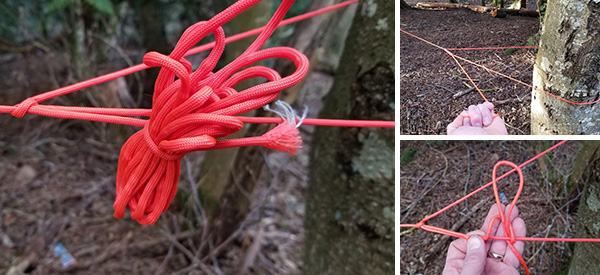














I am always impressed with knot tying skills but since I never use them I never remember them. I end of using the inferior knots I learned as a kid. Nice simple one topic article though.
I’ve used all these knots for years, they are very very handy, you well be amazed how often you will use them when your out in the world.
Have been using this knot for 50 years. Works for securing everything including trailer loads and even canoes on top of vehicles.
This is not a true truckers knot , if you can tell me where to send the pics , I can send you pics of a true truckers knot , I used to tie 80,000 pound loads with the knot I’m talking about , and I now live in the Philippines and use this same knot on my motorcycle!! And much more versatile that the knots you are using!!
I guess I am a rope purist! I hate to see any kind of rope with the ends all fraid out per your paracord. I either do a back splice or in the case of paracord heat the cut ends with a match to seal the ends. FYI I really liked your how to on the truckers knot. That is the only knot that for some reason does not “stick” in my brain! I can do the majority of knots in my sleep or behind my back but when I need to do a truckers hitch I might as well do a granny knot!
I always give an extra twist or two so it will be easier to undo later.
Good information
However, I think the Bowline is easier to tie and
much more useful
Yep, I use the bowline most often and the taut line hitch to snug down loads ( since I keep forgetting the truckers knot)
I use the Bowline as well and find it the quickest, easiest and strongest, plus extremely easy to undo. When working trees the load can be in the thousands of pounds. The Bowline holds strong, has never let me down and I can always get the knot out quick which in the tree business is life or death.
guess I’ll try this sometime…
but I prefer tauntline hitches, easier and quicker to tie.
https://en.wikipedia.org/wiki/Taut-line_hitch
Too complicated of a knot to make.
Helpful for sure! Knowing that there are different specific knots for different specific situations, is key. Having one with almost universal practical applications is most helpful! Truth be told, I always seem to fall back on the various knotting techniques that I learned practicing embroidery and lace making as a kid.
The ratchet strap has pretty much replaced rope for securing loads, but even in the old days nobody knew how to tie knots. Every new guy that ever came to work for me would almost immediately show up with a truck load of material secured with a tarp and a rope fastened in square knots all the way around. It always made me mad to watch a young fool wasting time trying to break all those hard knots so I would go out to the trailer and walk around it with my buck knife cutting the rope in to about twenty pieces. This was decades ago when it was okay for the boss to cuss out an employee, and I did plenty of that while explaining a knot had to be easy to loose in a hurry. Then a quick lesson in half and trucker’s hitches (and a new rope) and the problem was solved until the next new guy showed up. Now they don’t even let drill instructors cuss, what kind of world have we made?
I don’t know my knot language but there’s an easier way to tie a tight ridge line, secure to one tree and pull the line tight around the other tree, running end comes over the top of the line and loops back around the tree the other way, secure to the line with half hitches. Does that make sense? Do it right the 1st time or I’ll get mad.
But, if you learned the wrong way and did it that way for 40 years…it don’t make it right! p.s.- I started driving trucks when I got out of the army in 1973…I have used this knot thousands of times, the only problem I ever had was pulling such a bind on nylon or poly rope that the rope melted fron the heat of friction.
Informative!
I earned a badge in knot tying as a 10 year old. I nadd a display b oard or 32 knots. I’ve forgotten most after 64 yeas gave passed since then. The truckers knot ending with the slip kjot is a good one for tightening down a load. Ratchet straps are handy but there are times I definitely want a rope. And ending with the slip knot makes it easy to release.
Hubby always used a half sheet bend for the first loop, which falls out when the tension is released, and clove hitches to finish.
Of course these days it’s all ratchet straps or chains and binders to secure the load by law here.
there’s and easier way to do the knot. i’ve tied down 1000’s of loads with 1000’s of ropes. the knot looks the same but tied differently. its so easy to release to, just pull on the end and the knots release and the rope is as if you never tied a knot. its called a “red neck wench” (i didn’t name it)
You can save some time with step 1 (photo 1). Rather than pulling the entire length of line through the bowline, just make a bite through the bowline and place a stake or stick into the bite. Both the setup and takedown take less time
Looks like a clove hitch and a sheepshank got together and made a knot baby!
The tree and the hole.
The rabbit comes out of the hole, goes around the tree and goes back down into the hole…
I also put a little cinch on it for good measure.
The title of this article is a total miss, there is no single knot as “the only knot you need to know”. Similar to using tools, you need to use the right knot(s) for the job. Here’s a few more really good knots to know:
https://www.itstactical.com/skillcom/knots/5-knots-you-need-to-know-how-to-tie-at-all-times/
listen , you have to wash your hands , we now know you are that guy in the Blue man group!
Learn your knots, learn lots of knots, and practice your knots. You will one day be glad you did. I like to practice will watching TV, very relaxing.
Get yourself an old blue jackets manual. I teaches all the knots you will ever need. An old destroyer sailor.